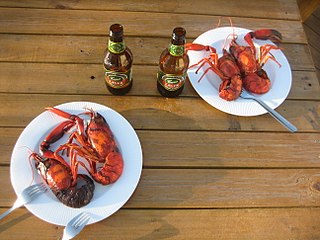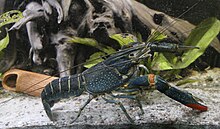
Crayfish are freshwater crustaceans belonging to the infraorder Astacidea, which also contains lobsters. Taxonomically, they are members of the superfamilies Astacoidea and Parastacoidea. They breathe through feather-like gills. Some species are found in brooks and streams, where fresh water is running, while others thrive in swamps, ditches, and paddy fields. Most crayfish cannot tolerate polluted water, although some species, such as Procambarus clarkii, are hardier. Crayfish feed on animals and plants, either living or decomposing, and detritus.

Marron is a name given to two closely related species of crayfish in Western Australia. Formerly considered a single species, it is now recognised as comprising two species, the critically endangered Cherax tenuimanus, and the species that is outcompeting it, C. cainii.

Cherax, commonly known as yabby/yabbies in Australia, is the most widespread genus of fully aquatic crayfish in the Southern Hemisphere. Various species of cherax may be found in both still and flowing bodies of freshwater across most of Australia and New Guinea. Together with Euastacus, it is also the largest crayfish genus in the Southern Hemisphere.

Macrobrachium rosenbergii, also known as the giant river prawn or giant freshwater prawn, is a commercially important species of palaemonid freshwater prawn. It is found throughout the tropical and subtropical areas of the Indo-Pacific region, from India to Southeast Asia and Northern Australia. The giant freshwater prawn has also been introduced to parts of Africa, Thailand, China, Japan, New Zealand, the Americas, and the Caribbean. It is one of the biggest freshwater prawns in the world, and is widely cultivated in several countries for food. While M. rosenbergii is considered a freshwater species, the larval stage of the animal depends on brackish water. Once the individual shrimp has grown beyond the planktonic stage and becomes a juvenile, it lives entirely in fresh water.

The common yabby is an Australian freshwater crustacean in the Parastacidae family. It is listed as a vulnerable species of crayfish by the International Union for Conservation of Nature (IUCN), though the wild yabby populations remain strong, and have expanded into new habitats created by reservoirs and farm dams.

Penaeus monodon, commonly known as the giant tiger prawn, Asian tiger shrimp, black tiger shrimp, and other names, is a marine crustacean that is widely reared for food.

Procambarus clarkii, known variously as the red swamp crayfish, Louisiana crawfish or mudbug, is a species of cambarid crayfish native to freshwater bodies of northern Mexico, and southern and southeastern United States, but also introduced elsewhere, where it is often an invasive pest.

The swamp barb, also known as chola barb, is a species of tropical freshwater fish belonging to the subfamily Cyprininae of the family Cyprinidae. It originates in inland waters in Asia, and is found in Pakistan, India, Nepal, Bangladesh, Sri Lanka, Bhutan, and Myanmar.

Ibacus peronii, the Balmain bug or butterfly fan lobster, is a species of slipper lobster. It lives in shallow waters around Australia and is the subject of small-scale fishery. It is a flattened, reddish brown animal, up to 23 cm (9 in) long and 14 cm (6 in) wide, with flattened antennae and no claws.

Euastacus is a genus of freshwater crayfish known as "spiny crayfish". They are found in the south-east of the Australian mainland, along with another genus of crayfish, Cherax. Both genera are members of the family Parastacidae, a family of freshwater crayfish restricted to the Southern Hemisphere.
Cherax quinquecarinatus is a small freshwater crayfish endemic to the south-west corner of Australia. It is one of two species known as gilgie, or jilgi, which is a seasonal food source for people of the region. Gilgies are found throughout a biogeographically isolated region of the coastal south of Western Australia and are significant in the ecology of aquatic systems of that bioregion.
Cherax nucifraga is a species of crayfish in the family Parastacidae. It is known only from the type locality – Palm Springs, near Channel Point, Northern Territory, Australia – where the holotype was collected from the stomach of a barramundi. It is listed as data deficient on the IUCN Red List.

Cherax parvus is a species of crayfish in the family Parastacidae. It is only known from its type locality – the Upper Tully River catchment in the Cardwell Range of north-eastern Queensland – and is listed as data deficient on the IUCN Red List. It was discovered in a rainforest catchment in a highland of northeastern Queensland during a Queensland Museum expedition to the upper Tully River area in November 1992. It is one of the smallest species in the genus. No species of Cherax has been considered endemic to wet upland or highland areas before it was discovered; most previous records were from elevations less than 400 meters. It also has several morphological features unique to the genus, and does not appear closely related to any extant species, suggesting a long period of geographic isolation.

Cherax holthuisi is a species of crayfish from the Bird's Head Peninsula in New Guinea. It grows to a total length of 81–93 mm (3.2–3.7 in) and is typically pink, orange or yellow in wild specimens. It was described in 2006 after animals circulating in the aquarium trade could not be assigned to any known species.

Crayfish are eaten all over the world. Like other edible crustaceans, only a small portion of the body of a crayfish is edible. In most prepared dishes, such as soups, bisques and étouffées, only the tail portion is served. At crawfish boils or other meals where the entire body of the crayfish is presented, other portions, such as the claw meat, may be eaten.

The eastern swamp crayfish is a species of small freshwater crayfish from coastal New South Wales, Australia. It is distinguished from related species by large genital papilla on the males, large raised postorbital ridges, a laterally compressed carapace, and elongated chelae.

Cherax snowden is a species of crayfish from West Papua in Indonesia. In the wild, they live in freshwater river tributaries. It is popular as a freshwater aquarium pet across Asia, Europe, and North America because of its orange-tipped claws. Specimens were previously misidentified as members of Cherax holthuisi, also from West Papua.

Cherax preissii, the common koonac, is a Western Australian freshwater crustacean in the Parastacidae family.
Cherax cainii, known as the smooth marron, is one of two species of crayfish that are endemic in Southwestern Australia known as marron. It occupies a range extending from around Hutt River in the north west to around Esperance in the south east of Western Australia. The species is also now found in variety of artificial and natural fresh water bodies of Queensland, South Australia, Victoria and New South Wales in Australia. It has also been introduced to other countries including North America, Chile, South Africa, Zambia, Japan and New Zealand as a part of commercial aquaculture schemes.

















